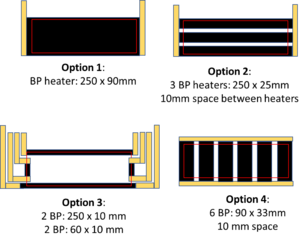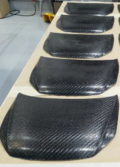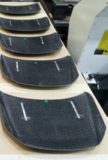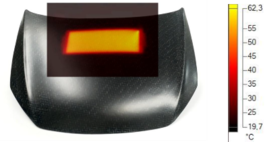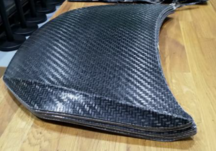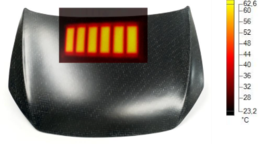ABSTRACT: OASIS Composites Open Innovation Test Bed (OITB) is a single-entry point for scale-up of Innovative Smart lightweight polymer matrix and aluminium composite materials and components. OASIS offers technological and business support services for accelerated innovation studies and success in industrialisation, market penetration and commercialisation of nano-enabled products (NEPs). IGESTEK (Spain) is a leading company in the development of technology projects: specialized in lightweight solutions using plastics and composite materials. In collaboration with Tecnalia (Spain), IPC (France), University of Patras (Greece), UCLM (Spain), TMBK (Poland) and AMIRES (Czech Republic) they identified an opportunity for the development of a heating system based on buckypapers (MWCNT films) for automotive exterior bodywork panels manufactured using recyclable thermoplastic composite material via a press moulding method.
Heater integration was screened using resistive heating, simple mechanical and microscopy analysis of the test panels. Coupon panels were manufactured (using optimised processing conditions) for thermal analysis. A prototype mould was designed and manufactured for the fabrication of representative demonstrator parts (1:3 scale car bonnet panel). Electrothermal analyses of four heater configurations were calculated, leading to the selection of two final demonstrator configurations. Ten functioning demonstrator panels were successfully manufactured based on these two designs. Thermal assessment of the integrity of the heaters was carried out via electrical resistive heating. The results of the collaboration confirmed that NEP based thin film heaters could successfully be integrated into thermoplastic composite panels via a compression thermoforming process.
RESUMEN: OASIS Composites Open Innovation Test Bed (OITB) es un punto de entrada único para la ampliación de materiales y componentes compuestos inteligentes e innovadoras de aluminio y matriz polimérica. OASIS ofrece servicios de apoyo tecnológico y empresarial para estudios de innovación acelerada y éxito en la industrialización, penetración de mercado y comercialización de productos nanohabilitados (NEP). IGESTEK (España) es una empresa líder en el desarrollo de proyectos tecnológicos: especializada en soluciones ligeras utilizando plásticos y materiales compuestos. En colaboración con Tecnalia (España), IPC (Francia), Universidad de Patras (Grecia), UCLM (España), TMBK (Polonia) y AMIRES (República Checa) identificaron una oportunidad para el desarrollo de un sistema de calefacción basado en buckypapers (MWCNT) para paneles de carrocería exterior de automóviles fabricados con material compuesto termoplástico reciclable mediante un método de moldeo a presión.
La integración del elemento calefactor se proyectó utilizando calentamiento resistivo, análisis mecánico simple y microscópico de los paneles de prueba. Se fabricaron paneles de cupones (usando condiciones de procesamiento optimizadas) para análisis térmico. Se diseñó y fabricó un molde prototipo para la fabricación de piezas de demostración representativas (panel del capó del coche a escala 1:3). Se calcularon los análisis electrotérmicos de cuatro configuraciones de calentadores, lo que condujo a la selección de dos configuraciones finales de demostración. Se fabricaron con éxito diez paneles de demostración en funcionamiento basados en estos dos diseños. La evaluación térmica de la integridad de los calentadores se llevó a cabo mediante calentamiento resistivo eléctrico. Los resultados de la colaboración confirmaron que los calefactores de película delgada basados en NEP podían integrarse con éxito en paneles compuestos termoplásticos a través de un proceso de termoformado por compresión.
Keywords: Nano-technology, Buckypaper, Smart composites, Improved safety, Structural component
1. Introduction
In response to the increasingly demanding Corporate Average Fuel Efficiency (CAFE) standards and the European Emission Standards (EES), automotive OEMs are focusing highly on enhancing the fuel efficiency of their vehicles by manufacturing lightweight cars with enhanced battery mileage. The OEMs have considered composite materials as the best substitute for traditional heavyweight materials such as steel and aluminium to manufacture lightweight, fuel-efficient, and strong impact resistant cars [1].
At the same time, the rise in the number of pedestrian accidents, has increased the demand for external airbags in the automotive market [2]. To avoid accidents, governments across the globe are implementing safety standards for automobiles and these standards have either already become or soon will become mandatory for all automobiles (2022 onwards) [3]. This factor is expected to fuel the growth of the automotive external airbag market, which obviously must be suitable for purpose regardless of the environmental conditions in which the vehicle is used [4].
This paper describes the development of a low-energy consuming electrothermal heater system that is suitable for integration in the composite based structure of a road vehicle in the failure zone immediately above an external airbag. The objective of this system is to ensure the correct “rupture” of the composite panel regardless of the ambient conditions. The design has been based on the hood of the VW segment C platform. The final demonstrator consists of a layered heating system integrated in a 1:3 scale car bonnet panel manufactured from thermoplastic composite organosheets using a compression moulding process.
The work was carried out as a joint development between Igestek and the service providers from the OASIS Composites Open Innovation Test Bed (OITB) through the industrial use case demonstrator project “HOTAIRBAG” as part of the H2020 OASIS project (GA 814581) [5].
2. Experimental Procedure
The aim of the work was to identify material solutions suitable for use in the automated manufacturing of automotive parts using preheating in an IR oven followed by thermoforming in a heated press, according to the parameters shown below.
- Composite preheating (IR oven): 190ºC-210ºC
- Preheat time: 1 to 3 min.
- Mould temperature: 80-120ºC
- Mould pressure: 100-350 bar
- Compaction time: 2-3 min.
2.1. Small scale trials
2.1.1. Material selection
The baseline material used wasTepex® Dynalite 104-RG600(x)/47% glass fibre (sheet thickness of 1mm), an organosheet PP/roving glass fibre composite sheet supplied by Lanxess.
The selected heater element material was buckypaper (BP), which is a self-supporting film comprised of entangled carbon nanotubes, manufactured, and supplied by Tecnalia. Two types of BP material were manufactured: standard BP (consisting only of MWCNTs) and a reinforced BP (consisting of MWCNTs filtered onto a porous PA6 membrane). The PA6 membrane was left integrated in the final material, acting as additional mechanical support to the thin MWCNT film.
In addition, ancillary materials (including conductive tapes, heater element connectors etc.) were identified, selected, and supplied.
2.1.2. Thermal calculations
ISIMHEAT (1D software) was used to calculate the power density needed to reach a target temperature via a ramp in temperature. The software enables calculation of through thickness thermal distribution only (i.e. not in plane distribution) and assumes that the thermal distribution in the heating layer is uniform. This is a simple method for identifying thermal effects in multilayer systems and has been used to estimate the power density requirements for the external airbag application.
To calculate the thermal power requirements, 4 heater design concepts were considered, based around a nominal heater area of 250 x 90mm. The designs were assessed for the two types of buckypaper material: standard BP (R = 3 ohms/sq) and reinforced BP (R = 30 ohms/sq).
Four heater configurations were considered:
- Option 1: single BP heater 250 x 90mm
- Option 2: 3 BP heaters 250 x 25mm each with 10mm spacing
- Option 3: 2 BP heaters 250 x 10mm + 2 BP heaters 60 x 10mm
- Option 4: 6 BP heaters 90 x 33mm each with 10mm spacing
2.1.3. Integration trials
Due to the manufacturing conditions, it was essential to assess their effect on the thin film materials, and so integration trials of BP heaters and metallic tape electrodes in the organosheet composite were carried out. This was mainly focused on the ability of these materials to withstand the industrial processing conditions.
PP organosheet test panels of approx. 140 x 80mm were cut and placed inside a metallic mould (140 x 80 x 1.76mm). This was used to contain the materials and minimise lateral flow during processing. A series of 50 samples were used to investigate factors that were considered critical to the successful integration of the heater element into the composite panels, including:
- Effect of BP type: standard or reinforced BP
- BP perforation level: Unperforated (UP); Single perforated (SP); Double perforated (DP)
- Perforation dimensions: Pinned holes; punched holes
- BP location: Surface; integrated between organosheet layers
- PP organosheet orientation: symmetric, non-symmetric
- Electrodes: Metallic adhesive tape, placed on both sides of the BP using different perforation levels
2.1.4. Thermal screening
Prior to the integration of the buckypaper heater elements, electrothermal tests were carried out to evaluate the uniformity of the temperature distribution and to identify any defects or hot spots in the material. The electrical resistance of each sample was measured using a Keysight 34461A digital multimeter. The buckypaper was placed within a vacuum bag over an electrically insulated surface (to ensure a fully flat surface and a uniform heat transfer). The power was manually applied to the specimen using a programmable power source and the electrical parameters were increased until the surface of the specimen reached approx. 60˚C. During the test, the surface temperature of the specimen was monitored and recorded using an Optris PI160 infrared camera.
All trial material/panels were assessed before and after the compression moulding integration trials via this electrical resistive heating method. Process optimisation was determined by comparing the effect of the processing parameters on the “before and after” electrical/thermal properties of the materials, including changes in the thermal profile, creation of hot spots or failure of the heater element.
2.2. Scaled demonstrator manufacturing
The aim of the integration trials was to identify the optimum materials, heater design and processing parameters required for the manufacture of the final 1:3 scale demonstrator panels. A purpose mould was designed and constructed specifically for the manufacture of these scaled parts. Different mould design options were considered (metal/metal, silicone/metal, etc) as well as different manufacturing routes (machining, 3D printing, etc). An aluminium design using a machining process for the manufacture of both halves of the mould was finally selected.
The heater materials, circuit design and processing parameters for these demonstrator parts were selected based on the results from the material integration trials. The thermal screening method used for the integration trials was also used to assess the effect of the manufacturing process on the integrity of the heater circuits.
3. Results
3.1. Small scale trials
3.1.1. Thermal calculations
Table 1 describes the results of the thermal calculations of the four heater configurations.
| Configuration | Standard BP | Reinforced BP | ||||
| R (Ω) | V (V) | I (A) | R (Ω) | V (V) | I (A) | |
| 1 | 8,3 | 27 | 3,25 | 83 | 85.5 | 1.03 |
| 2 | 10 | 29,7 | 2,97 | 100 | 94 | 0.94 |
| 3 (long BP)
3 (short BP) |
75
18 |
27
6.5 |
0.36
0.36 |
750
180 |
85.5
20.5 |
0.114
0.114 |
| 4 | 1,36 | 10,94 | 8,04 | 13,6 | 34.54 | 2.54 |
The power requirements of the heaters were assessed according to their suitability for both standard car batteries (12 V; capacity = 60 Ahwith power output = 720 Wh) and electric car batteries (400V with power output = 30-100 kWh). Based on the thermal calculations the standard BP material was identified as the most suitable material. The reinforced BP material had a resistance 10 times higher than the standard BP material leading to significantly higher power requirements.
This data was also used to select configurations 1 and 4 for the circuit designs in the final demonstrators. Configuration 3 was excluded due to the large differences in power requirements for the two parts of the circuit. Configuration 2 was retained as a backup solution.
3.1.2. Integration trials
Both standard and reinforced BP materials survived the processing and were successfully integrated in the organosheet material. Perforating the BP material helped to increase the bonding with the PP matrix (improving overall integration and adhesion of the two sheets), but also led to significant weakening of the BP material. This in turn led to several failures. The dimensions of the pinned hole were insufficient to enable suitable matrix flow and led to BP breakage. Punched holes improved matrix bonding but weakened the BP material, which again led to heater breakage.
Both types of BP materials survived well when integrated at the surface of the organosheets, but significant process optimisation was needed to improve the survivability of the BP material when placed between the organosheet layers. However, as the preferred solution was aimed at a fully integrated heater within the composite structure the main effort was aimed at the development of this integration route. In addition to the BP material, metallic adhesive tape was successfully integrated to create the internal circuits and connections to the BP heater element.
Initial trials identified an induced curvature in the panels caused by non-symmetric organosheet arrangement (glass fibre orientation). Using a symmetric arrangement of the fibre orientation avoided these deformations.
3.1.3. Thermal screening
Thermal test results of the samples in which the standard BP heater was successfully integrated showed good uniform heating up to 92ºC, indicating good resistance to the processing conditions. The final composite also had a good uniform surface finish.
 
(a) |
 
(b) |
The reinforced BP was seen to be less resistant to the process, had a less uniform heating profile after integration and the final composite had a lower surface quality. As this material had a higher electrical resistance than the standard BP, the required voltage needed to be higher to achieve the same target temperatures. Based on the observations of the two materials during the trials, the standard BP material was selected for the final demonstrator manufacturing.
3.2. Scaled demonstrator manufacturing
1/3 scale demonstrators were manufactured using the optimised process parameters identified during the small-scale manufacturing trials.

(a) |
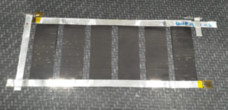
(b) |
Resistive heating of the buckypaper materials was carried out before and after integration according to the previously described method. For the Configuration 1 heaters the temperature was increased from 20 to 60-65ºC using a voltage of 25V. The results showed that homogenous heating was achieved and compared well with both thermal calculations as well as the previous results from the integration trials. The highest thermal gradient across an individual heater was only 6ºC.
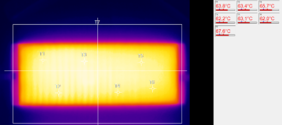
(a) |
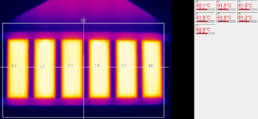
(b) |
For the Configuration 4 heaters the temperature was increased from 20 to 60-65ºC using a voltage of 12V. Whilst three of the panels had thermal gradients less than 5 ºC, overall there was a slightly larger thermal gradient across all panels (max = 19ºC) when compared to those for Configuration 1. These higher values appeared to be due to slight deformations in the heater elements caused by the manufacturing process. The electrical requirements compared well with those identified by the thermal calculation data.
4. Conclusions
The OASIS OITB funded HOTAIRBAG project has successfully developed a heating system (based on the standard Buckypaper material) that is capable of integration in a thermoplastic based composite structure via compression moulding. The development within the demo case has considered the requirements of the processing route for a potential application in the automotive sector for use with an external airbag protective system for pedestrians. The developed system is suitable of directing available power from a battery to heat the panel within predefined temperature ranges. Simulations have shown that the heater design/arrangement is critical to achieve target temperatures at lower voltages. Several designs were assessed, and two of these configurations were selected for integration in the final 1/3rd scale demonstrator panels. Five demonstrator panels of each design were successfully manufactured.
Thermal analysis of the panels confirmed the capability of the systems to achieve these temperature ramps under ambient conditions.
5. Acknowledgements
The authors would like to acknowledge the funding received from the European Union’s Horizon 2020 research and innovation programme under grant agreement No 814581.
Bibliografía
| [1] | “Automotive Composites Market - Global Forecast to 2028,” Market Report CH 2907, April 2023. [Online]. Available: https://www.marketsandmarkets.com/Market-Reports/automotive-composite-market-10869121.html. |
| [2] | “Fortune Business Insights,” Automotive Pedestrian Protection System Market Research Report (2023-2030) FBI103588, 2022. [Online]. Available: https://www.fortunebusinessinsights.com/automotive-pedestrian-protection-system-market-103588. |
| [3] | “General Safety Regulation (GSR) - EU Regulation 2019/2144,” 27 November 2019. [Online]. Available: https://eur-lex.europa.eu/legal-content/EN/TXT/PDF/?uri=CELEX:32019R2144. |
| [4] | “Global Automotive Airbag Market 2021-2026,” 2022. [Online]. Available: https://mobilityforesights.com/product/automotive-airbag-market/. [Accessed 10 April 2023]. |
| [5] | U. Calvar, “OASIS Multidisciplinary Network of Technological infrastructures and associated services for lightweight smart materials development.,” 2023. [Online]. Available: https://oasis-composites-oitb.com/. |
Document information
Published on 15/10/23
Accepted on 28/08/23
Submitted on 21/05/23
Volume 08 - COMUNICACIONES MATCOMP21 (2022) Y MATCOMP23 (2023), Issue Núm. 2 - Fabricación y Aplicaciones Industriales - Sostenibilidad y Reciclaje., 2023
DOI: 10.23967/r.matcomp.2024.02.10
Licence: Other
Share this document
Keywords
claim authorship
Are you one of the authors of this document?
